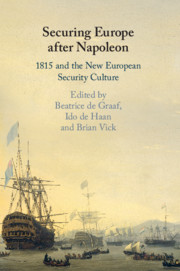Book contents
- Securing Europe after Napoleon
- Securing Europe after Napoleon
- Copyright page
- Contents
- Contributors
- Vienna 1815
- Part I Conceptualisations
- Part II Institutions and Interests
- 4 The Central Commission for the Navigation of the Rhine
- 5 From the Balance of Power to a Balance of Diplomacy?
- 6 The London Ambassadors’ Conferences and Beyond
- 7 The Allied Machine
- 8 The German Confederation
- Part III Threats
- Part IV Agents and Practices
- Index
5 - From the Balance of Power to a Balance of Diplomacy?
Peace and Security in the Vienna Settlement
from Part II - Institutions and Interests
Published online by Cambridge University Press: 25 January 2019
- Securing Europe after Napoleon
- Securing Europe after Napoleon
- Copyright page
- Contents
- Contributors
- Vienna 1815
- Part I Conceptualisations
- Part II Institutions and Interests
- 4 The Central Commission for the Navigation of the Rhine
- 5 From the Balance of Power to a Balance of Diplomacy?
- 6 The London Ambassadors’ Conferences and Beyond
- 7 The Allied Machine
- 8 The German Confederation
- Part III Threats
- Part IV Agents and Practices
- Index
Summary
The European peace and security system established in the course of the Congress of Vienna is presented here as a more complex arrangement than conveyed in the traditional political model of the balance of power. The statesmen and diplomats who drafted the settlements of 1814-1815 genuinely and succesfully sought to ban war and to establish a lasting peace after the long and bloody wars against Napoleon, a peace which endured until the outbreak of the Crimean War in 1853. Instead of a balance of power based on mutual military deterrence, they arrived at a balance of negotiation, a compromise based on active cooperation. As such, the order of Vienna, though imperfect, was a definite refinement compared to the traditional paradigm of the balance of power inherited from the Treaty of Utrecht. It created a Concert of Europe, which even beyond its impact throughout the nineteenth century still frames a European political ethos up to this day.
Keywords
- Type
- Chapter
- Information
- Securing Europe after Napoleon1815 and the New European Security Culture, pp. 95 - 113Publisher: Cambridge University PressPrint publication year: 2019



